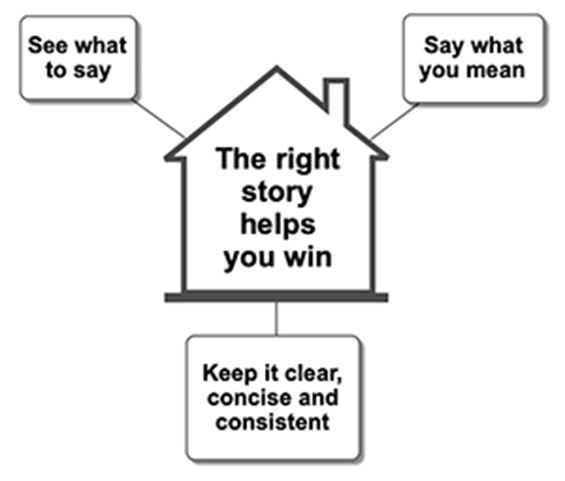
Want more results from your marketing? Make it simple.
The 60-page marketing plan. The novel-length email. The 84-slide presentation one of your employees wants to give at a conference.
Does the thought of reading any of those make you groan? I thought so. There’s a reason we’ve all heard the phrase, “Keep it simple.”
This is the first in a series of blogs on making communications and marketing simple. Struggling to make something simple? Email your questions to ariana@crystalclearcomms.com. I’ll answer the most common questions in my blog.
Simple words and phrases are easier to process and therefore understand.

Think about it.
“Walk” versus “ambulate.” “Indolent” versus “lazy.”
If your content is simple and easy to understand, your audience gets your message more quickly, especially since they are likely not reading your content word-for-word. And I’ve never met a doctor who was offended by the use of the phrase “heart attack” instead of “myocardial infarction.”
Yet many communicators and marketers I’ve worked with struggle to keep their content simple. Why?
Because making things simple takes time. There’s a reason the famous quote “I would have written a shorter letter, but I didn’t have time” is attributed to so many different people.
If you want better results from your content, make it simple.
Make your words simple
One good place to start is by simplifying your words. This can be a struggle at first, especially if you have executives or other content approvers who think long words make them sound smarter.
I once worked with an executive who always changed “use” to “utilize.” The lightbulb for him finally when off when I said, “I’m never going to get utilized to this.”
Sometimes you need to point out that your readers will not be offended by simpler words. And your content will be easier and faster for them to read and process.
I often use the heart attack example in my messaging and media training workshops. It helps executives understand that simple is not offensive.
Make your messaging simple
Do you find that your company and/or product messaging tries to be all things to all people? That your product leaders want every feature included in every communication? That often happens when everyone wants a say.
But your audience has a short attention span, and you only have about eight seconds to catch their attention. Sometimes you have to remind yourself and others that the point of marketing is to get buyers interested enough to contact you to learn the details.
One of the best ways to ensure your message is clear, concise and consistent is to make a one-page Message Map.

“With a Message Map, you see what to say and say you what you mean,” says George Stenitzer, my partner and founder of Crystal Clear Communications. “You can color-code the map to make sure the message is relevant to different audiences.”
From vaccinations to climate change, there is a lot of research that shows simple messages are clearly more effective. And in marketing, “decision simplicity,” which is how easy clients can gather reliable information, is the single biggest driver of client attraction and retention.
“Even in the complex world of healthcare information technology, a message is most effective when it’s clean and straightforward, and not cluttered with unnecessary, superfluous language,” says Tom Lynch, Director of Marketing Communications at Allscripts. “For example, let me rephrase that last thought: ‘To be most effective, keep your message clean and simple.’”
Make your marketing strategy simple
Now about that 60-page marketing plan. What if you could ditch it? What if you could clearly state your marketing goals, objectives, strategies and metrics on one page?
It would be much easier for your entire department to stay on the same page and remain on track throughout the year. As a bonus, your executives could easily read and understand what marketing is doing for the company.
It’s not as hard as it seems. With this template as your guide, you can create a clear, concise overall strategy that fits on one page. You can then use the overall plan to make clear one-page plans for all of your marketing needs, from your website to trade shows and events.
Make your measurement simple
Now that you’ve simplified your strategy, it’s much easier to simplify your metrics. Do you really need to report on every single item? Especially items that can be misleading, such as time spent on one of your web pages. How many times have you left a web page up while you went to a meeting or to get a cup of coffee?
“While your marketing analytics team may need to keep an eye on a larger number of metrics, you need to boil those down to simple key performance indicators (KPIs) for your leadership,” says Michael Klozotsky, Chief Marketing Officer at Intelligent Medical Objects.
“Those KPIs should measure what really matters, such as conversion rates, instead of number of webinars you hosted. If you put the number of webinars you hosted in front of a business unit leader, they’re just going to ask you what that actually means for the business. Numbers that lack meaning or context are what Avinash Kaushik calls a ‘data puke,’ — and all they do is overwhelm and obfuscate deeper insight.”
Simple, clear messages are easier to process and understand than complex ones. Yet the lack of time and too many people giving input often lead marketers to deliver longer-than-needed messaging and content. Taking the time to simplify will yield better results in the long run.
Struggling with a marketing or communications issue you’re trying to simplify? Email me, and I may answer it in one of my next blogs.
For more tips on how to deliver on-message communications, subscribe to our blog.
Related Posts
Ideas to simplify your message
Here’s a summary and review of Ben Guttmann’s new book, Simply Put – Why Clear Messages Win – and How to Design Them. Everyone...
Media interview? Read these tips to be successful on the phone.
A media interview is a great way to get your company’s story heard. But in this day and age, with people scattered all over...
What size should my marketing team be?
As we look at a potential recession, clients continue to ask me: what is the ideal size for my marketing team? The answer is...
Are you afraid of naysayers when presenting?
Recently I’ve had several clients ask me how to handle naysayers when presenting. Most of us have heard that presenting and public speaking are...





